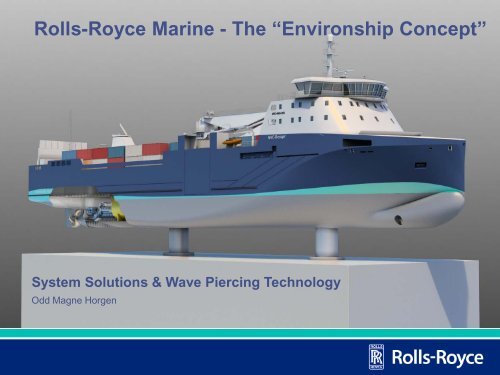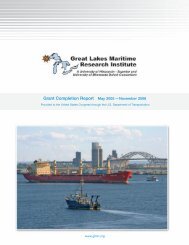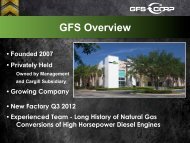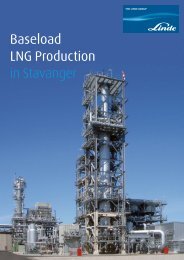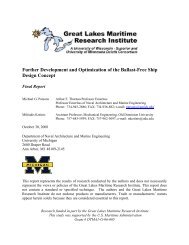Rolls-Royce Marine - The “Environship Conceptâ€Â
Rolls-Royce Marine - The “Environship Conceptâ€Â
Rolls-Royce Marine - The “Environship Conceptâ€Â
Create successful ePaper yourself
Turn your PDF publications into a flip-book with our unique Google optimized e-Paper software.
<strong>Rolls</strong>-<strong>Royce</strong> <strong>Marine</strong> - <strong>The</strong> “Environship Concept”System Solutions & Wave Piercing TechnologyOdd Magne Horgen
Content• <strong>Rolls</strong>-<strong>Royce</strong> in general1910• Engines• Environmentally friendly system solutions2007• LNG as fuel for marine engines
<strong>Rolls</strong>-<strong>Royce</strong> plcWorld leading supplier addressing four global markets:Civil Aerospace Defence Aerospace <strong>Marine</strong> Energy• Aero engines• Helicopter engines• Aero engines• Helicopter engines• Ship Design• Equipment systems• Gas turbines39 000 employees<strong>Rolls</strong>-<strong>Royce</strong> data - Restricted
<strong>Rolls</strong>-<strong>Royce</strong> design & integrated ship systemsAUTOMATEDHANDLING SYSTEMSENGINESELECTRIC SYSTEMPROPULSIONAUTOMATIONMANOEUVRINGCustomerDECK MACHINERYOne contact, one supplier, one deal = a safe & cost-effective solution
Bergen Engines 2012Core to a “green strategy” 2012
Bergen EnginesEngines & Foundry- 800 employees- 6500 engines sold- 3500 in operation- 556 gas engines- 40 gas marine
Engine RangeC25:33 engine (2002-)C26:33 engine (2010-)B32:40 engine (2001-)B35:40 engine (2003-)•Output•Bore x stroke•Speed range•BMEP•Fuel types1840 - 3000 kW250 x 330 mm900 - 1000 rpm22.2 - 26.7 barMDO, HFO•Output•Bore x stroke•Speed range•BMEP•Fuel types1400 - 2500 kW260 x 330 mm900 - 1000 rpm18,2 barNatural Gas LNG• Output 2765 - 8000 kW• Bore x stroke 320 x 400 mm• Speed range 720 - 750 rpm• BMEP 24.9 bar• Fuel types MDO, HFO• Output 2625 - 9600 kW• Bore x stroke 350 x 400 mm• Speed range 720 - 750 rpm• BMEP 18.2&20 bar• Fuel types Natural Gas, LNG•Propulsion and Gen.set applicationsInline: 6-8-9•Propulsion and Gen.set applicationsInline: 6-8-9• Propulsion and Gen.set applicationsInline: 6-8-9V type: 12-16• Propulsion and Gen.set applicationsIn line type:6-8-& 9Vee type : 12-16-20345 C engines sold 16 C gas engines sold1100 B engines sold141 B gas engines sold
Why natural gas? <strong>The</strong> Drivers !!• Price• Emissions
Cruise ship destination, NorwayGeirangerBergen - Harbour 2011But what if the shipemissions ruin it…?Foto: Atle Daae Andersen
Emissions, the technology driver:Spark Ignited lean Burn Gas Engines:• ~92% reduced NO x emission• ~22% reduced GHG emission• 100% reduced SO x emission• Zero smoke• Low unburnt fuel slip• Low number of particles• Low maintenance cost
Core Technology Status• Gas Engines, compliant with the current IMO II legislation andIMO III from 2016• Bergen Engine nett GHG (CO2-CH4 slip) reduction is 22%• Diesel Engines, compliant with the current IMO II legislation. Requries subequipmentto meet IMO III from 2016.1816NOx curves14NOx (g/kWh)121086B32:40 CDIMO Tier I (2000)IMO Tier II (2011)C25:33 CD420IMO Tier III 2016B35:40 gasC26:33 gas0 130 200 400 600 750 800 1000 1200 1400 1600 1800 2000 2200Rated Engine Speed
Ways of reducing emissionsGas powered propulsionHybrid propulsion• GHG 22%• NOx - 92%• SOx - 100%• Particulate - 98%High efficiency propulsion andmanoeuvring systems: PROMASAdvanced hull formsup to -8%Application for patent protection by <strong>Rolls</strong>-<strong>Royce</strong>up to -8%
Fjord 1; MF BoknafjordBERGEN Gas engine technology – 24,6 knotsElectric Propulsion system; 3 x C2633L9AGas + 1 x C25:33L9A mdoand 4 x 100 AZPFuel reduction >30% compared to first 5 ships (7,5 % from engine)
NorLines - Cargo40% Green House Gas reduction!!22% from engine 18% from design and PromasComplete design and equipment package:Gas engine, Gear box, propeller, LNG tank, ACON-HSG system
Eidsvåg shipping at STX BrattvågComplete design and equipment package:Gas engine, Gear box, propeller, LNG tank, ACON-HSG system
HYBRID SHAFT GENERATORShaft generator to switchboard power flow control. Engine and propeller can operate at variable speeds Stable network frequency Fixed voltageBenefits. Reduced fuel consumption Flexible operations Optimised propulsion mode selection Longer engine life and reduced maintenance Increased comfort on board Improved redundancyROLLS-ROYCE HSG – HYBRID SHAFT GENERATOR
HYBRID SHAFT GENERATORA range of operational modes Boost mode Transit mode Parallel mode Diesel/gas electric modeROLLS-ROYCE HSG – HYBRID SHAFT GENERATOR
<strong>The</strong> new Bukser & Berging tug2 x C26:33L6PG @ 1705kW, 1000rpm2 x Aquamaster US 35
Bunkring Ship to Ship (STS)Complete design and equipment package:Gas engine, Gear box, propeller, LNG tank, ACON-HSG system
Bunkring Ship to Ship (STS)Complete design and equipment package:Gas engine, Gear box, propeller, LNG tank, ACON-HSG system
Gas availability21Today (2012)• Gas availability steadily increasingworldwide• LNG carriers (like “Corale Methane”)will bring gas from main- to smallerterminals and ports• Gas distributors ready to increase gasavailability based upon demand• Gas supply in Europe superceed theLNG demand from ships per today• Volume of LNG will drive down LNGprice
Example : LNG bunkering processFjord1 Ferry “MV Raunefjord”22<strong>The</strong> bunkering station on board
GHG (Green House Gases) from gas engines• 1t diesel emits 3,2t CO2• 1t natural gas emits 2,55t CO2• <strong>The</strong> difference is 20% reduction• Due to higher energy content in gas the possible GreenouseGas reduction is almost 30%• Uncombusted Methane has a GHG effect factor 21-25 timeshigher than CO2• If unburned methane is released from the combustion theGHG reduction is quickly eroded
GHG reduction vs fuelconsumptionReduction of GHG in % comparedto a standard Diesel engine with aspecific consumption of185 g/kWh%403020100-10-20-30Gas engine fuel consumption in g/kWh200 190 180 170 160 1500 3 6 9 12E2 weighed methane slip in g/kWhRR C engine
Methane emission: Gas vs. Dual FuelMethane emission g/kWh45403530252015105025 50 75 100Engine Load (%)100 % load:267 % diff.50 % load:421 % diff.Engine 1 DFEngine 2<strong>Rolls</strong>-<strong>Royce</strong> C26:33L9AGSource : MarintekMethane emission is 21-25 times more aggressive Green House Gas than CO2
Natural gasSpark ignitionHigh efficiencyMethane number 70Load response similar to adiesel engine.Minimum emissionsSimplicityLower maintenance cost26No abatement systems needed<strong>Rolls</strong>-<strong>Royce</strong> data-strictly private
Multi-fuel systemCompression ignitionSome compromises toaccommodate the two fuels.After-treatment to meet ECA/EPAregulations?
Natural Gas as Fuel for Future VesselsNO X - 92 %GHG(CO2-Methane slip) - 8 %SO X - 100 %Particulate - 98 %Invisible smokeNo oil spill• 35 daily port calls 51000/year• Engines have run more than 35.000 hrs since Jan 2007• NOX reduction = 160,000 cars running for 1 year
Summary• <strong>Marine</strong> Gas engines represents well proven technology.• LNG is available – increased demand will ensure even betterdistribution network.• Dual fuel engines are the choice when enough LNG cannot becarried to complete the voyage.• Where the application allows single fuel marine gas engines:• More efficient• Less expensive in terms of operating and life cycle cost.• Lower emissions, reduced GHG by net 22%• Less complex engine supporting systems.• Methane number 70• Green profile for the ship owner – marketing tool.
Bergen Gas engines for ships:• 556 gas engines sold, over 400 in operation• More than 20 mill hrs. experiences• Plants with more than 140.000 hrs.• <strong>The</strong> 5 ferries are doing 35 port calls/day-51000/year.• <strong>The</strong> ferry Engines have logged from 18000 - 35000 running hours sinceJan 2007So far 23 gas engines for marine are in operation"the most economic way to comply withfuture requirements“NO OILSPILL DURING BUNKERING<strong>The</strong> cleanest marine engine on the market today
BERGEN gas engine January 2012Fjord1 - “Bergensfjord” (2 x KVGS-12G4 + 2 x KVGS-16G4)Fjord1 - “Fanafjord” (2 x KVGS-12G4 + 2 x KVGS-16G4)Fjord1 - “Raunefjord” (2 x KVGS-12G4 + 2 x KVGS-16G4)Fjord1 - “Mastrafjord” (2 x KVGS-12G4)Fjord1 - “Stavangerfjord” (2 x KVGS-12G4)Fjord1 - “Tresfjord” (1 x C26:33L9AG + 1 x BRM-6 (diesel))Fjord1 - “Boknafjrod” (3 x C26:33L9AG + 1 x C25:33L9LACD (diesel)) w AZP propulsionTorghatten “ferry 1” (1 x C26:33L9PG) & propulsionTorghatten “ferry 2” (1 x C26:33L9PG) & propulsionTorghatten “ferry 3” (1 x B35:40V12PG) & propulsionTorghatten “ferry 4” (1 x B35:40V12PG) & propulsionNSK Shipping (1 x C26:33L6PG) & propulsionRRM Eidsvåg Shipping 1 x C26:33L9PG & propulsionSea Cargo “vessel 1” (1 x B35:40V12PG) hull 357 & propulsionSea Cargo “vessel 2” (1 x B35:40V12PG) hull 358 & propulsionCoral Methane 2 x KVGB-12G4 + 2 x B32:40L8A (MFO/HFO)) & propulsionIsland Offshore #1(UT776 CDG) @ 2 x C26:33L9AG + 2 x C25:33L6A CD & propulsionIsland Offshore #2(UT776 CDG) @ 2 x C26:33L9AG + 2 x C25:33L6A CD & propulsionNorlines #1 TBN NVC design, 1xBL35:40L9PG & propulsionNorlines #1 TBN NVC design, 1xBL35:40L9PG & propulsionBukser & Bergning 2 x 2 x C26:33L6PGas + 2 x Aquamaster US35 FPP system
32Clean enginecrankcase room….25000 running hrs<strong>Rolls</strong>-<strong>Royce</strong> data-strictly private
Thanks for your attention!Designed for robustness,harsh operational environments, andexceptional levels of reliability
Questions?


